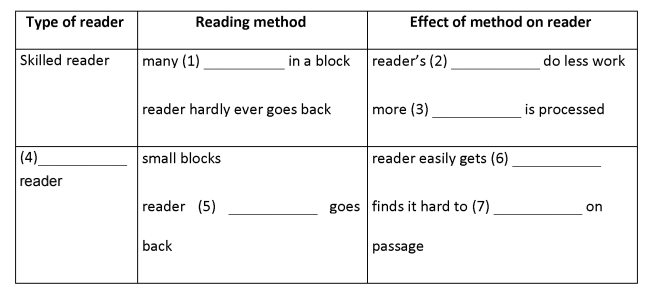A. Most people learn to read either letter by letter or word by word. As you improve, this changes. You will probably find that you are fixing your eyes on a block of words, then moving your eyes to the next block of words, and so on. You are reading blocks of words at a time, not individual words one by one. You may also notice that you do not always go from one block to the next: sometimes you may move back to a previous block if you are unsure about something.
B. A skilled reader will read a lot of words in each block. He or she will only look at each block for an instant and will then move on. Only rarely will the reader’s eyes skip back to a previous block of words. This reduces the amount of work that the reader’s eyes have to do. It also increases the volume of information that can be taken in over a given period of time.
C. On the other hand, a slow reader will spend a lot of time reading small blocks of words. He or she will skip back often, losing the flow and structure of the text, and muddling their overall understanding of the subject. This irregular eye movement quickly makes the reader tired. Poor readers tend to dislike reading because they feel it is difficult to concentrate and comprehend written information.
D. The best tip anyone can have to improve their reading speed is to practice. In order to do this effectively, a person must be engaged in the material and want to know more. If you find yourself constantly having to re-read the same paragraph, you may want to switch to reading material that grabs your attention. If you enjoy what you are reading, you will make quicker progress.A. Most people learn to read either letter by letter or word by word. As you improve, this changes. You will probably find that you are fixing your eyes on a block of words, then moving your eyes to the next block of words, and so on. You are reading blocks of words at a time, not individual words one by one. You may also notice that you do not always go from one block to the next: sometimes you may move back to a previous block if you are unsure about something.
B. A skilled reader will read a lot of words in each block. He or she will only look at each block for an instant and will then move on. Only rarely will the reader’s eyes skip back to a previous block of words. This reduces the amount of work that the reader’s eyes have to do. It also increases the volume of information that can be taken in over a given period of time.
C. On the other hand, a slow reader will spend a lot of time reading small blocks of words. He or she will skip back often, losing the flow and structure of the text, and muddling their overall understanding of the subject. This irregular eye movement quickly makes the reader tired. Poor readers tend to dislike reading because they feel it is difficult to concentrate and comprehend written information.
D. The best tip anyone can have to improve their reading speed is to practice. In order to do this effectively, a person must be engaged in the material and want to know more. If you find yourself constantly having to re-read the same paragraph, you may want to switch to reading material that grabs your attention. If you enjoy what you are reading, you will make quicker progress.

mọi người giúp em với ạ
